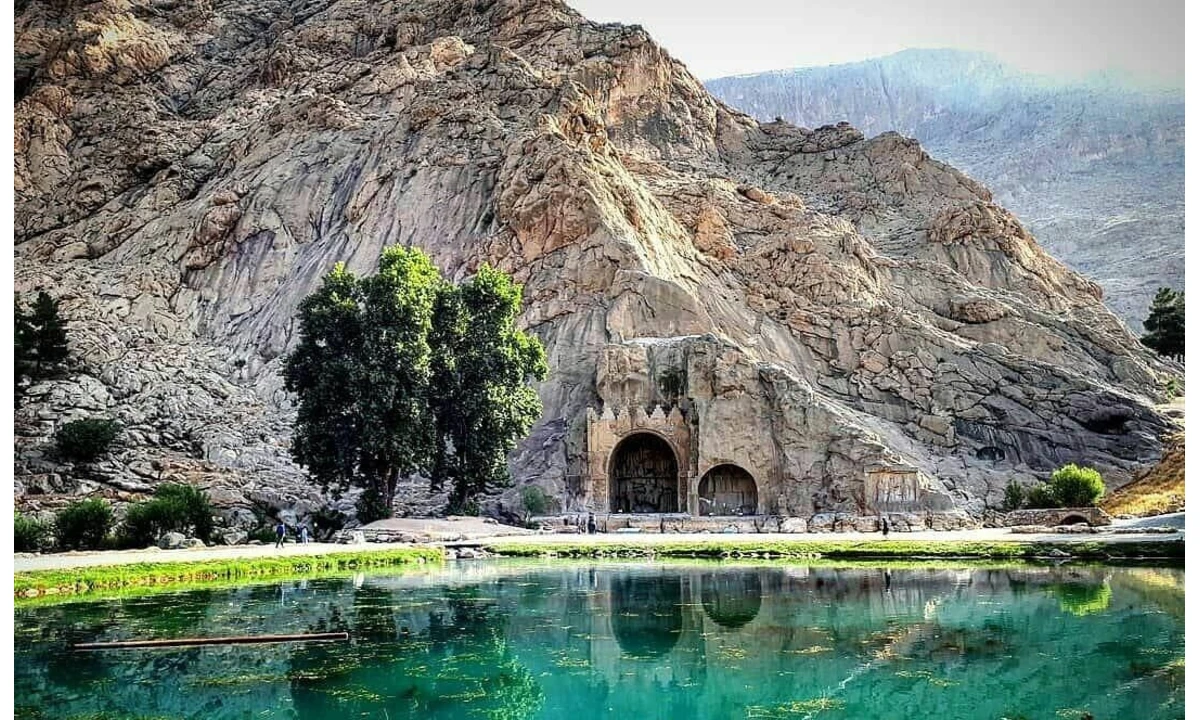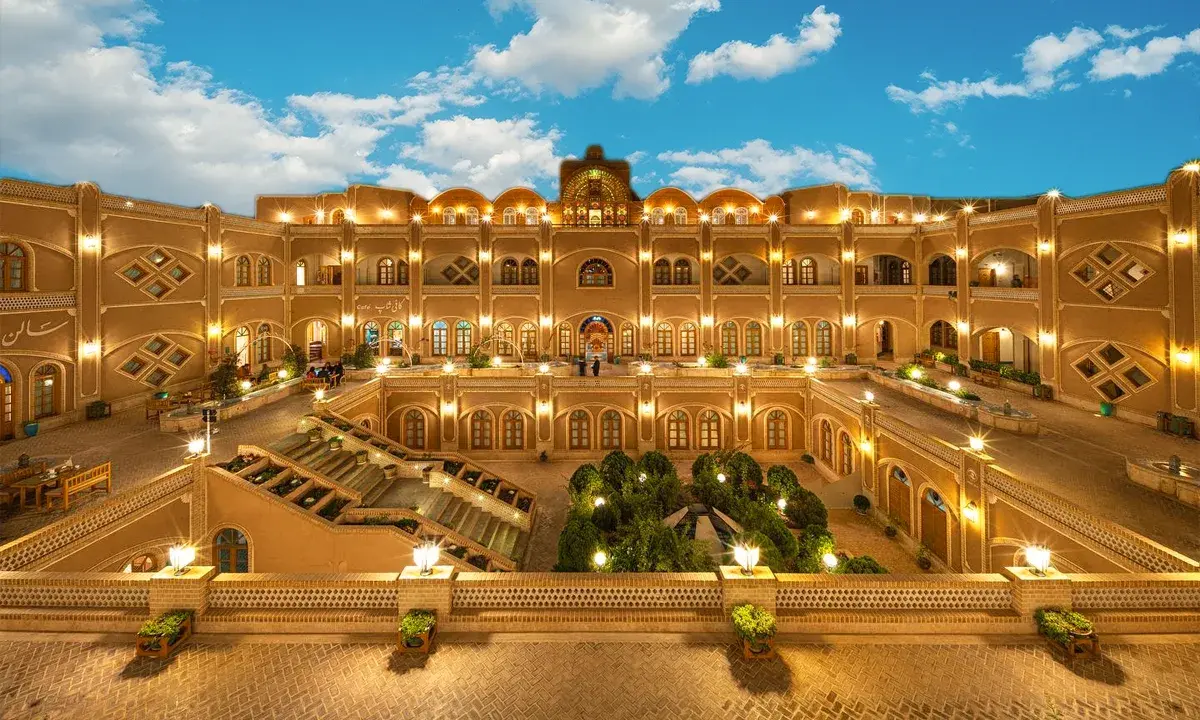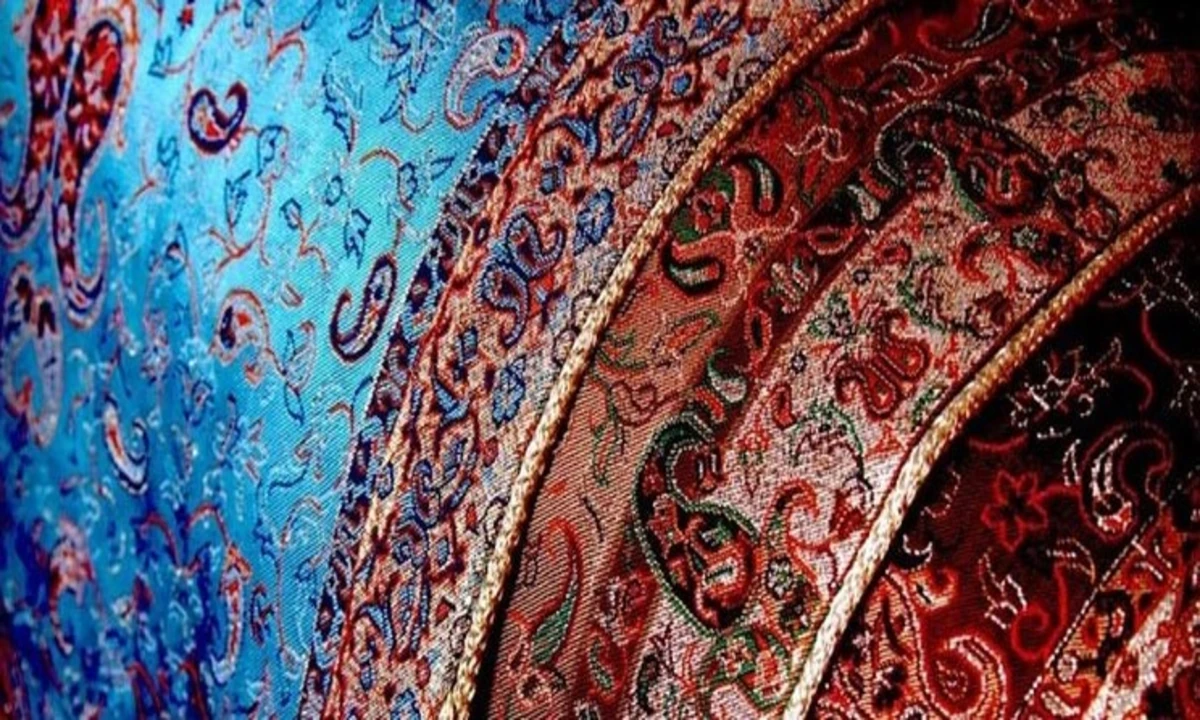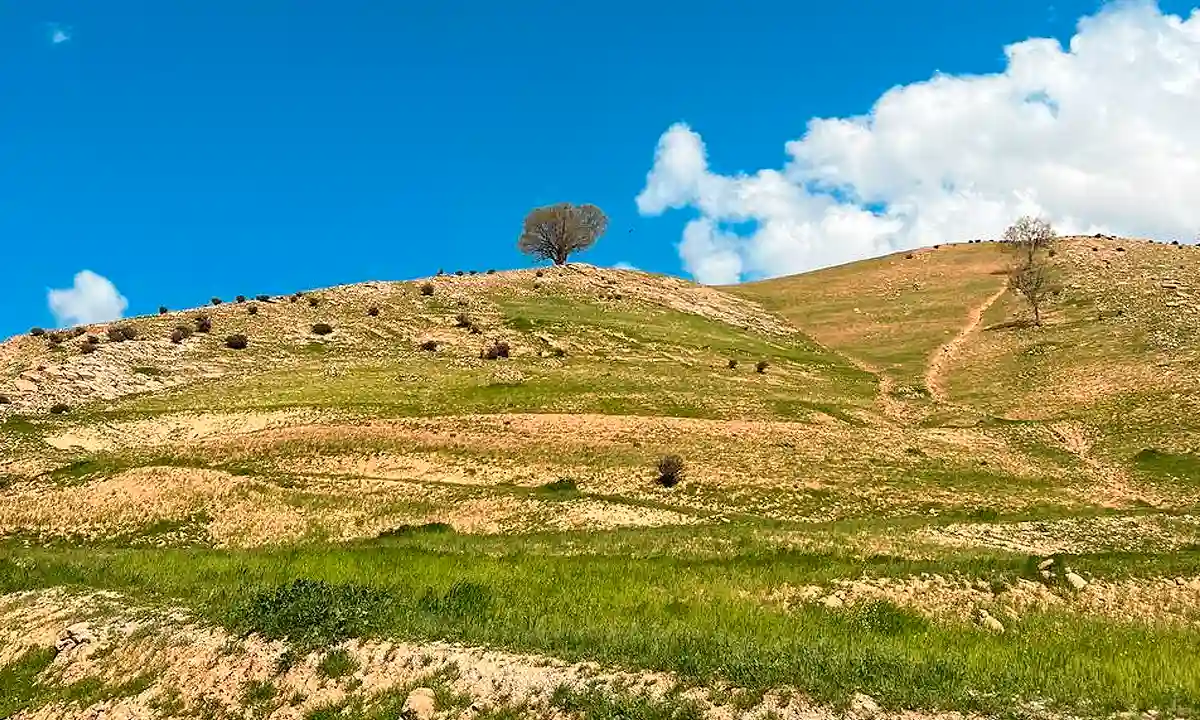Explore Chehel Sotoun Palace - Isfahan's Premier Historical Monument
![]() Author : shiva | Date : Saturday 30 November 2024 16:22
Author : shiva | Date : Saturday 30 November 2024 16:22

Isfahan, a city celebrated for its vibrant paintings, colorful portraits, and a rich tapestry of design, color, art, architecture, and history, offers a visual feast to all who visit. Amidst this beauty, Chehel Sotoun Palace stands out for its exquisite paintings and magnificent mirrors, historically hosting distinguished guests from across the globe.
The palace once served as the official site for political ceremonies and meetings with visiting kings and dignitaries. Presently, a section of Chehel Sotoun has been transformed into a museum dedicated to the preservation and exhibition of artworks and historical photographs from Isfahan, known as the Chehel Sotoun Museum. This splendid mansion, comprised of various sections, draws numerous visitors each year.
Curiosity often arises as to why the palace, with its twenty pillars, is named Chehel Sotoun, meaning "Forty Columns." The mystery unravels in the reflection of the twenty pillars in the waters of the mansion's pool, creating the illusion of forty pillars in total, a testament to the architectural ingenuity of the past.
Of course, another reason for this is the role of the number 40 in Persian literature, which indicates that it is large and plentiful, such as another Persian phrase that includes this issue.
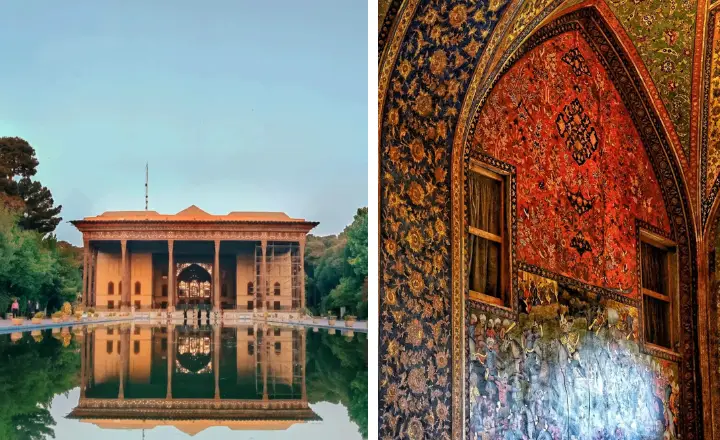
Chehel Sotoun garden
Chehel Sotoun garden has three entrances, located on the east side of it. By entering the garden from its main entrance, after a short distance, there will be a large pool in front of the mansion and then the main building. The main axis of the garden shows the direction of movement with the help of trees on both sides toward the main palace. This garden has a very small slope that helps to flow into the stream.
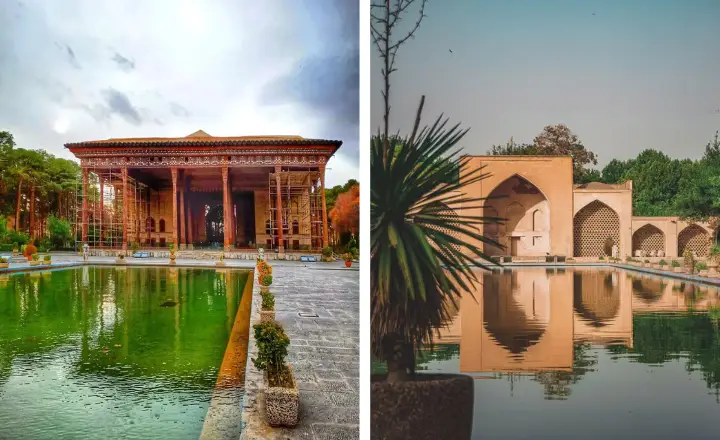
40 pillar palace is separated by walls from its surroundings in the city, and today its connection with other urban elements is very limited. The connection between the major urban elements of Naqsh-e Jahan square and other public historical buildings is a symbol of the urban structure; this inner connection was created with the help of intermediate indoor interiors such as entrances and attachments.
Chehel Sotoun Museum
Chehel Sotoun Museum is also named after this palace and is famous among the people. This museum is a place to preserve the collection of works of Chehel Sotoun Palace and other objects, books, and manuscripts from Isfahan. These collections are a unique example of Iranian art.
✔️Read More : Isfahan Travel Guide 2024 | Things to Do in Isfahan
Chehel Sotoun History
Isfahan Chehel Sotoun Palace is an example of a royal garden from the Safavid period. By the year 1327, due to the lack of precise history, it was difficult to comment on the history of the Chehel Sotoun construction. But in the same year, as a result of the excavations, on the front of the courtyard, a poem was found in two inscriptions below the plasters, the shorter one on the background of the caricature, attributing the construction of its Hall to Shah Abbas II, while the other one that its lines are on the blue background, shows the building repair on the time of Shah Sultan Hussein.
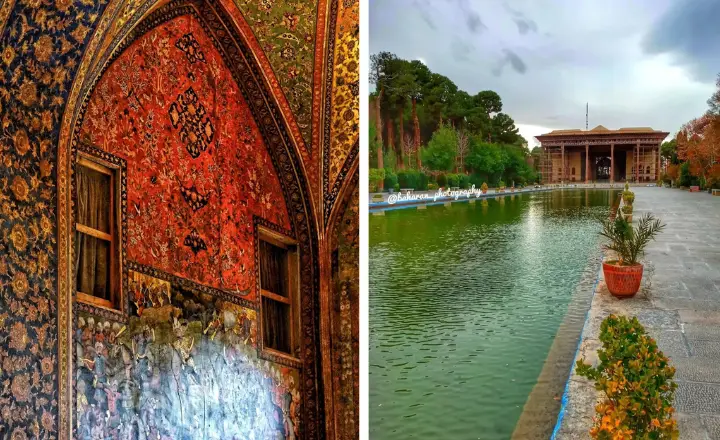
One of Shah Abbas's plans, after choosing the city of Isfahan as the capital, was the construction of the beautiful and long Chahar bagh Street and numerous gardens around it. The successor of the gardens, which is reminiscent of the concept of the Garden in the Garden, was the principles of the Isfahan like other gardens. Today, except for Behesht Garden and Chehel Sotoun Garden, other ones have disappeared and only their names remain.
Inside Chehel Sotoun palace, Shah Abbas designed a cape craft building with small rooms around it, which is considered the core of the garden. This courtyard was used to receive guests from the king's court at celebrations.
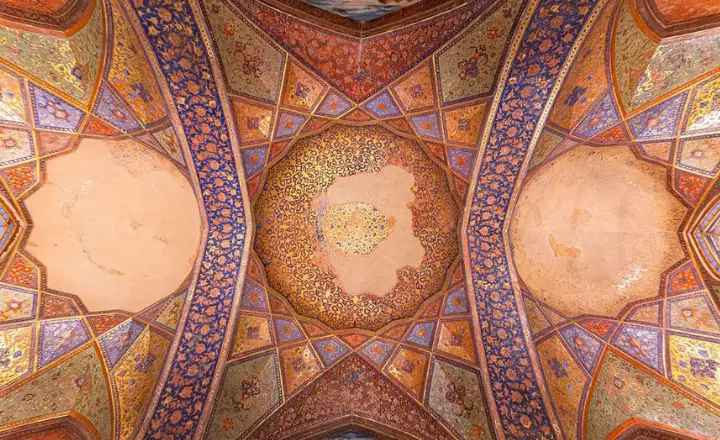
Since then, after the reign of King Abbas II, the seventh king of Safavid, the Chehel Sotoun mansion has been enlarged and has added forums and porches. These include the Mirror Hall, the Eighteenth Column Hall, the two large rooms of the North and the South, the porches on the sides of the King's Hall, and the Great Basin in front of the Hall with all the decorations of painting, mirroring, tiling of the walls and ceilings. The spacious courtyards of the palace during the second time of Shah Abbas have also been the venue for public lodges and formal reception lodges. The palace opened with the presence of Shah Abbas II and foreign ambassadors.
✔️Read More : Discover the Ali Qapu Palace in Isfahan
Chehel Sotoun Architecture
The architecture of this palace is a combination of Chinese, Iranian, and European art and architecture. It consists of the main porch that is built east-facing. The octagonal pillars of this porch are made from Smooth wood and pine and the four middle columns are located on four stone lions.
The ivory of the Chehel Sotuon palace is composed of two parts: a section with 18 wooden columns and 4 pillars in the middle are placed on 4 stone limes and their carvings are in such a way that two lions are shown to one human head. From the mouth of these four water lilies and erupted into the marble dock of the hall.
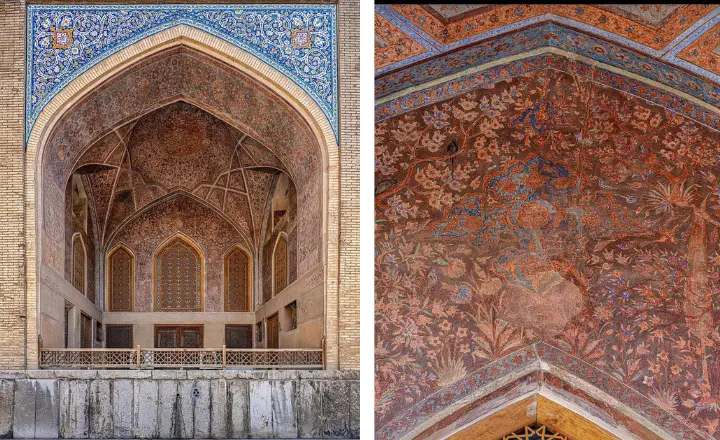
The other part, which is slightly higher, forms the entrance to the hall and is called the mirror hall. It is surrounded by two pillars and is adorned with a wide and proliferative mirror work in which little glittering mirrors are used beside big and long mirrors. The roof hall is made of wooden frames and in various geometric shapes. The image of the marble hollow in the middle of the porch is visible in the ceiling decoration. This mirroring is very similar to Ālī Qāpū. The central hall of the palace, which was dedicated to foreign guests from other countries, contains paintings that present the historical events of different periods. This magnificent hall is based on a dome, with colorful paintings and golden and transparent designs.
Some of these paintings were painted in the Qajar era, and are descriptions of the acceptance of Shah Abbas I and II, and Tahmasp I from kings of Turkestan and India, as well as the war of Shah Ismail I with Uzbeks. Two other images, one opposite the entrance to the hall and the other to it, show the Chaldoran War during the time of Shah Ismail I and the Karnal War in the era of Nader Shah Afshar.
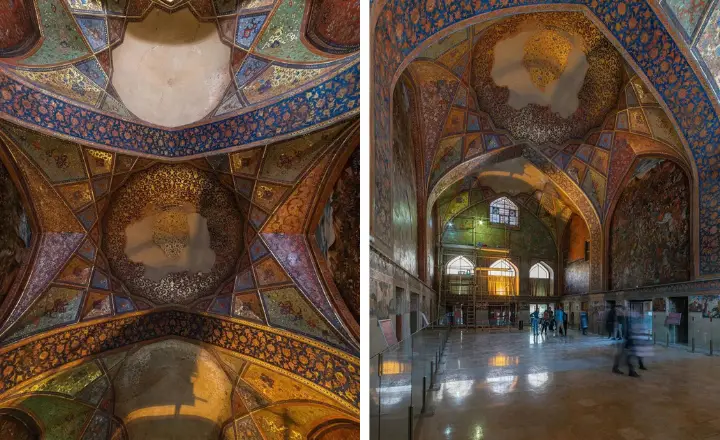
Useful Information for Foreign Tourists Visiting Chehel Sotoun Palace
Entrance Tickets: Tickets can be purchased at the entrance. There may be separate fees for access to the museum and special exhibitions within the palace. Discounts are often available for students, so be sure to ask if you're eligible.
Best Time to Visit: The best time to explore Chehel Sotoun Palace is during the spring (March to May) and fall (September to November) when the weather is mild. Early mornings are less crowded, offering a more peaceful experience.
Photography Guidelines: Photography is allowed in most parts of the palace and garden, but flash photography may be prohibited inside to protect the artworks. Always look for signs or ask staff before taking photos.
Dress Code: Visitors are advised to dress modestly, respecting local customs. This means shoulders and knees should be covered. A scarf for women to cover their hair might be required when entering certain areas.
Language Support: Informational brochures and signages in English and other languages are available at the entrance. For a more detailed understanding, consider hiring a local guide who speaks your language.
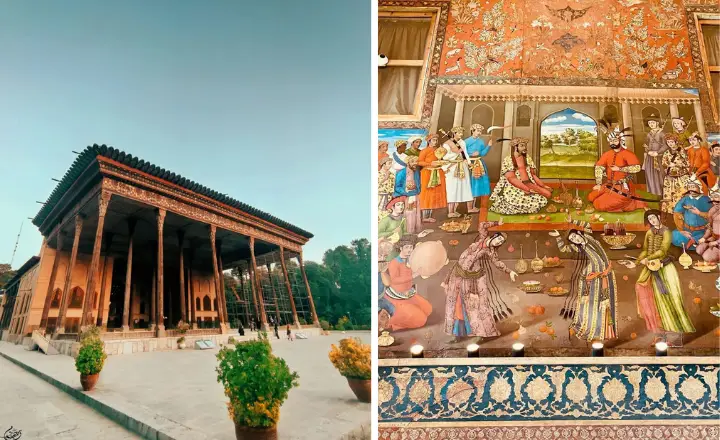
Facilities: The palace complex includes basic visitor facilities such as restrooms and a small cafeteria. The cafeteria offers refreshments and a place to rest during your visit.
Cultural Etiquette: Respect the palace's historical significance by behaving quietly and considerately. Large groups are encouraged to maintain a low volume, especially in enclosed exhibition spaces.
Accessibility: While the palace grounds are relatively accessible, some areas may present challenges for those with mobility issues due to uneven surfaces or steps. Check ahead for specific accessibility information.
Location and Transportation: Chehel Sotoun Palace is located in Isfahan, easily accessible by public transport or taxi. If unsure about directions, ask your hotel for the best route or consider booking a taxi through them.
Near Attractions: Combine your visit with other nearby attractions in Isfahan, such as Naqsh-e Jahan Square, to make the most of your day exploring the city's rich cultural and historical offerings.
Last Word
Questions and answers about the isfahan chehel sotoun palace:
Chehel Sotoun Palace stands as a testament to the rich cultural and historical heritage of Isfahan. Its unique architecture, the serene beauty of its gardens, and the depth of history captured within its walls make it a must-visit landmark. This palace not only showcases the artistic and architectural prowess of the Safavid era but also serves as a bridge connecting the past with the present. As you walk through its halls, you're invited to reflect on the stories and events that shaped this magnificent site, making every visit a journey through Iran's storied past.
FAQ
Questions and answers about the isfahan chehel sotoun palace:
What does "Chehel Sotoun" mean, and why is the palace so named?
"Chehel Sotoun" translates to "Forty Columns," named for the twenty pillars reflected in the palace's pool, creating the illusion of forty. This naming also reflects the significance of the number forty in Persian culture, symbolizing abundance and plenitude.
Can visitors explore the Chehel Sotoun Museum within the palace?
Yes, visitors can explore the Chehel Sotoun Museum, which houses an extensive collection of artworks, photographs, and historical documents from Isfahan, offering a deeper understanding of the region's heritage
What are the opening hours of Chehel Sotoun Palace?
Daily Hours: 9 AM – 6 PM.


